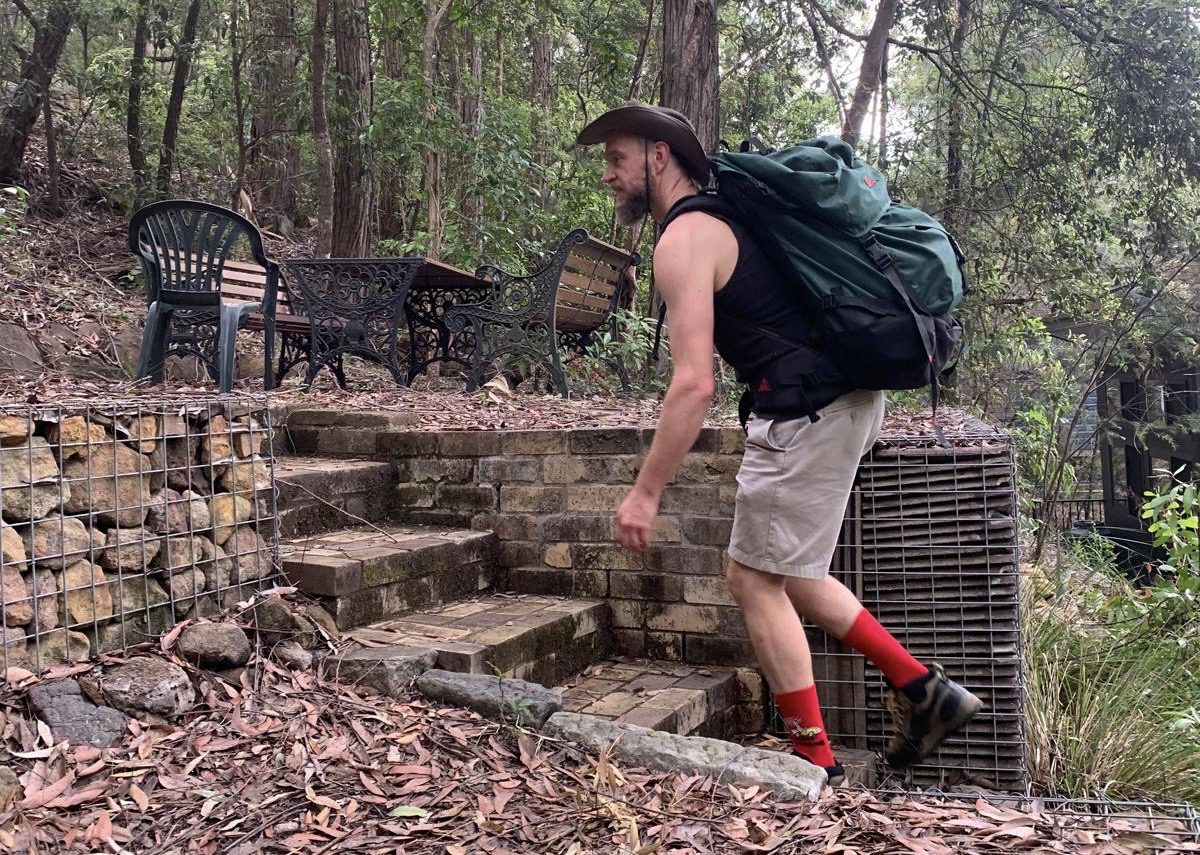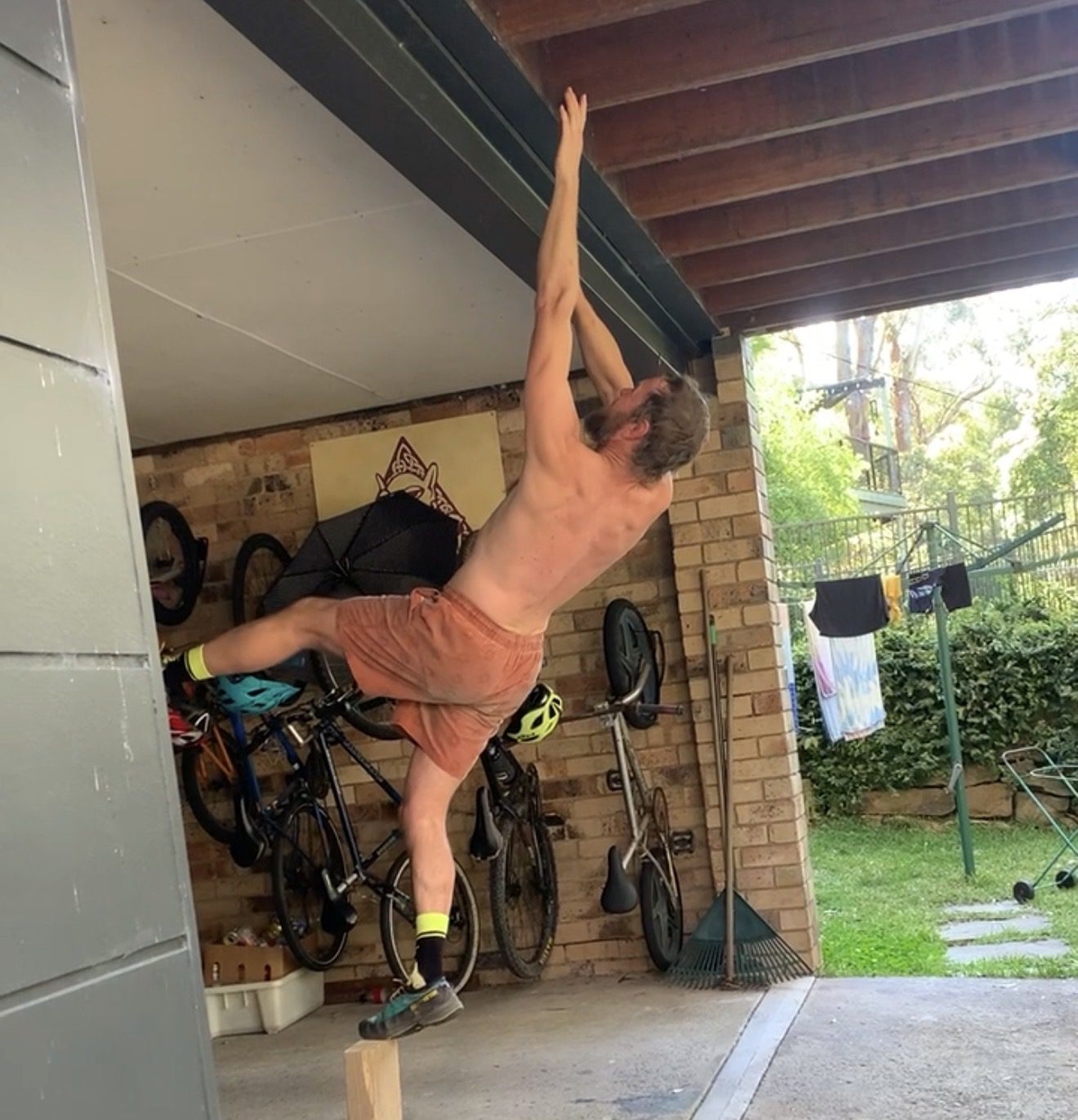
How Colin, a Sydney Dad of 3, trained for Ginsberg (19) in the Warrumbungles using pack-walks, auto-belays & campus board. Here's his run down.
Duncan and I climbed a couple of routes on Bluff Mountain pre-Covid and have been talking about getting back to the Warrumbungles ever since, but a little pandemic, then some projects in the Wolgan Valley kept causing us to put it off. However, after spending the Anzac long weekend enjoying some fine German beverages at a variety of lookouts in Blackheath, we finally committed to the next route on the list; Ginsberg, which the guidebook refers to as ‘a route with a reputation’.
On our last trip we had climbed Aladinsane, which is only about 30 metres to the left of Ginsberg and covers very similar terrain; very steep, a bit of loose rock, and quite difficult route finding (compounded by a rather vague description in the guidebook). And, at grade 19, very close to the limit of my trad leading for such a long route (330 m). I didn’t really lead any of Aladinsane and was feeling rather intimidated by the prospect of climbing Ginsberg, but also keen to redeem myself a little, and at least lead a few of the pitches.
So, it was time to train!
Luckily, Duncan is way out of my league, and has climbed many world-class routes, so I work on the assumption that as long as I can keep up with him and keep moving we’ll be OK, so I focused on two main things;
The approach to Bluff Mountain takes about two hours, and the routes are long, so you need a fair bit of gear, and lots of water, so you need to carry quite heavy packs just to get there. Because Duncan’s most important job is saving the day when the climbing gets hard, I consider my main job to be carrying lots of stuff in order to save his energy for when it really matters.
So that was a big part of my training;
- Walking to and from work/the shops (via all the big hills) with a pack full of climbing gear and water
- Walking laps up and down the very steep track through the bush in our backyard (with a pack)
- Walking to the nearest crag, via the hills, with a pack, for top-rope laps, then back home.
- And just to top it off, walking (yep, with a heavy pack) to the bottom of our valley to hang out with a mate on the Saturday night before the trip.
So legs were taken care of, but then I also needed to be able to hold on for long enough to be able to lead some fairly long pitches on quite steep ground.

“Training for long pitches of trad-climbing without climbing long pitches of trad is a bit hard, but I’ve had a bit of practice at doing that, so I hit the auto-belays, the campus board, an obscure route on the back of a road-cutting, and a few other home-made specials.”
My training regime included;
- LOTS of fingertip pull-ups with a lock-off and reach. On the hang-boards and campus board at Climb Fit St Leonards, and everywhere else I could find, preferably with really bad footholds, for a bit of extra core! (see garage training pic below)
- 15 minute sessions on auto-belay, climbing up and down, and trying to spend as long as possible in each position, finding rests and shaking out (which is essential for placing protection).
- As above, but on the bouldering wall, but maybe more like 5-10 minute sessions…
- Hour-long sessions on top-rope self-belay on a road cutting off the side of the Comenarra Parkway. Climb, abseil, repeat….
- more pull-ups…
- A big morning at Berowra with some of the Friday night social climbing crew.
- Standing on small footholds in the back corner at St Leonards until my calves were screaming, then standing there for a bit longer…
- more pull-ups with reaches with even worse footholds…

Four weeks out from the trip I was feeling very intimidated by the prospect of the climb, and very unprepared for it. Ninety percent of the training I’ve described above took place in the following three weeks, by the end of which I felt I was just fit enough. A family camping trip, then the skiing trip meant I couldn’t keep up the same intensity of training, but I was fairly confident that I would be fit enough to keep up…
So, was it enough?
The answer....sort of.
We made it up, and I led two of the solid pitches, but some route-finding difficulties on the second of these (pitch 4) meant that I ended up doing some significantly harder climbing than we were bargaining for. This left me a bit drained of energy (both physically and mentally) and I had to back off from pitch 6 when it turned out to be 15 m of technical climbing, not 6 m like it said in the route description.
Duncan took over from here, and with his seemingly endless reserves of physical and mental energy, sent that pitch, then launched into the crux pitch, with a similarly vague description to guide him. The lead took him an hour, and ended up being close to 60 m long, with some absolutely wild exposure in the final metres, looking straight down at our starting point 250 m below.
Two more pitches of relatively easy climbing followed, and we reached the top with a couple of hours of daylight, and a little bit of water to spare. From there it was about an hour’s walk back to our bags (and Yeti bottle full of ice-cold G&T), then a cruisy hour and a half back to the van.
- Depending on your baseline, three weeks probably isn’t enough (and I like to think my baseline isn’t that bad…)
- It obviously depends on how much training you can fit it. I did as much as I could, but had to squeeze it in between work and ballet/swimming lessons and making dinner and the rest of life.
- Experience and knowledge count for a lot too. We knew what sort of route we were doing and exactly what was going to be involved.
- A really strong partner doesn’t hurt either…
What about Duncan’s plan for us to climb every route on Bluff Mountain then? Looks like I’ve got a date with the campus board.

Here are some more resources for you to check out;
Blog - transitioning to outdoor climbing
Blog - how to improve your climbing endurance
Videos - Rope skills with the ASM and Climb Fit
Australian School of Mountaineering (ASM) have helped lots of our crew get trained up for outdoor adventures. Check out their huge range of courses. The ASM also run indoor Learn to Lead and Anchors courses here at Climb Fit in Sydney.
